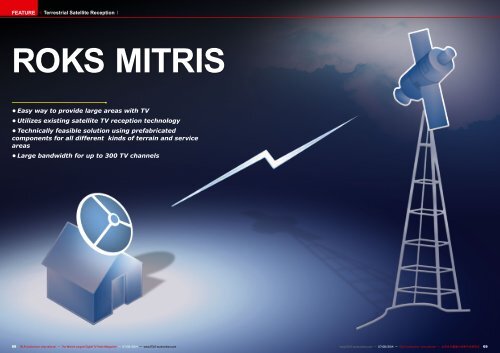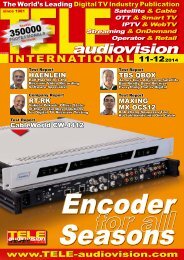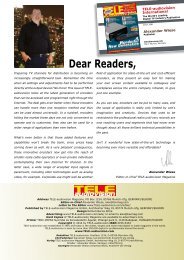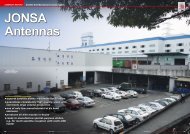ROKS MITRIS
You also want an ePaper? Increase the reach of your titles
YUMPU automatically turns print PDFs into web optimized ePapers that Google loves.
FEATURE<br />
Terrestrial Satellite Reception<br />
<strong>ROKS</strong> <strong>MITRIS</strong><br />
• Easy way to provide large areas with TV<br />
• Utilizes existing satellite TV reception technology<br />
• Technically feasible solution using prefabricated<br />
components for all different kinds of terrain and service<br />
areas<br />
• Large bandwidth for up to 300 TV channels<br />
68 TELE-audiovision International — The World‘s Largest Digital TV Trade Magazine — 07-08/2014 — www.TELE-audiovision.com<br />
www.TELE-audiovision.com — 07-08/2014 — TELE-audiovision International — 全 球 发 行 量 最 大 的 数 字 电 视 杂 志 69
FEATURE<br />
Terrestrial Satellite Reception<br />
Satellite Frequencies<br />
Transmitted<br />
Terrestrially<br />
Vitor Martins Augusto<br />
1<br />
When a provider wants to bring their<br />
digital TV programming to their customers,<br />
there are several ways to do<br />
this: via satellite, via cable or terrestrially.<br />
Each one of these methods comes<br />
with advantages and disadvantages.<br />
With satellite a provider can broadcast<br />
to large areas all at once and there<br />
are enormous bandwidths available<br />
which, in turn, results in extra costs<br />
and, depending on the type of content<br />
that is transmitted, may also require<br />
encryption.<br />
Not only that, the bandwidth on<br />
the most popular satellites is already<br />
booked.<br />
A cable network gives the provider<br />
the ability to offer additional services<br />
such as telephone and Internet, in addition<br />
to normal TV, through a return<br />
channel. Yet the installation of all the<br />
cabling brings with it very high costs<br />
and really only makes sense in areas<br />
with higher population densities.<br />
Terrestrial transmissions take place<br />
using a network of reduced-power antennas.<br />
Even here it becomes problematic<br />
to provide TV service to large regions<br />
because the ratio of the number<br />
of customers to the number of broadcast<br />
antennas needed is not profitable.<br />
Far more relevant is the fact that terrestrial<br />
TV such as DVB-T/T2 in many<br />
2<br />
1. Satellite TV reception from a terrestrial<br />
antenna. The principle behind <strong>MITRIS</strong>:<br />
a terrestrial transmitter using satellite<br />
frequencies<br />
2. Typical infrastructure for <strong>MITRIS</strong>.<br />
Content is streamed to a multiplexer and<br />
then modulated to DVB-S/S2. Transmission<br />
is made through omni-directional<br />
terrestrial antennas, instead of uplinking<br />
to a satellite. Reception, however is not<br />
different from a traditional satellite TV. Just<br />
point the dish to the transmitter antenna.<br />
countries is only allotted a minimum<br />
amount of bandwidth and the VHF/UHF<br />
frequency bands are used for other<br />
mobile services such as LTE.<br />
The answer for some time has been<br />
MMDS. This acronym stands for Multichannel<br />
Multipoint Distribution Service.<br />
It has to do with terrestrial transmission<br />
in the 2.5 to 2.7 GHz frequency<br />
range. 33 channels, each with 6 MHz<br />
bandwidth can be transmitted (in the<br />
USA it‘s only 31 channels) in this higher<br />
frequency range. What‘s special about<br />
this is the modulation of the digital<br />
signal: just like with cable it‘s either<br />
64QAM or 256QAM. But since there are<br />
already other services in use in this<br />
frequency band, MMDS was expanded<br />
out of which came, among other things,<br />
<strong>MITRIS</strong>.<br />
<strong>MITRIS</strong> stands for Microwave Inte-<br />
standard satellite broadcast.<br />
The frequency band used by <strong>MITRIS</strong><br />
is also used for satellite reception. If<br />
the antennas transmitting the <strong>MITRIS</strong><br />
signals are located too close to the satellite<br />
antennas disturbances can ocurr,<br />
especially in high geographic latitudes<br />
where the satellite antennas have a low<br />
elevation.<br />
A solution to overcome these problems<br />
is to install the <strong>MITRIS</strong> antennas<br />
separate from the satellite antennas or<br />
by making use of natural reflectors or<br />
of intentionally putting up reflectors. In<br />
any event, installing a <strong>MITRIS</strong> systems<br />
requires careful planning to not disturb<br />
satellite signals.<br />
In exactly the same way that the<br />
same frequency band from different<br />
satellites can be used independently<br />
from each other, <strong>MITRIS</strong> can also be<br />
used without having to worry about different<br />
signals, i.e. satellite and/or MI-<br />
TRIS interfering with each other.<br />
This is a great way to utilize the limited<br />
availability of frequency bands making<br />
<strong>MITRIS</strong> the ideal solution for TV distribution<br />
in rural areas and even more<br />
so in mountaines regions with its many<br />
natural obstacles which can be used favorably<br />
as a reflector to tune out undegrated<br />
Tele Radio Information System<br />
and operates in the Ku-band satellite<br />
frequency range. Another advantage<br />
over the original MMDS is the output<br />
transmission power used: it is lower<br />
(less than 10 mW) with almost the<br />
same coverage.<br />
Because of this, <strong>MITRIS</strong> antenna<br />
masts can be installed very close to<br />
residents without incurring any of the<br />
dxrawbacks that would result from<br />
excessive radio waves. Naturally, this<br />
simplifies the setup of <strong>MITRIS</strong> and simultaneously<br />
reduces the costs involved<br />
since antennas can be mounted,<br />
similar to mobile telephone services, on<br />
existing structures.<br />
With a bandwidth of 800 MHz, significantly<br />
more channels can be broadcast<br />
with <strong>MITRIS</strong> in the 11.7 to 12.5 GHz<br />
frequency band since it has enough<br />
room for up to 25 transponders. This<br />
would yield an impressive 200 to 300<br />
TV channels depending on the bandwidth<br />
and modulation used.<br />
It should be pointed out that <strong>MITRIS</strong><br />
does not transmit a polarized signal so<br />
it doesn‘t matter if the LNB operates<br />
in the horizontal or vertical position.<br />
For this reason only half as many transponders<br />
are available compared to a<br />
70 TELE-audiovision International — The World‘s Largest Digital TV Trade Magazine — 07-08/2014 — www.TELE-audiovision.com<br />
www.TELE-audiovision.com — 07-08/2014 — TELE-audiovision International — 全 球 发 行 量 最 大 的 数 字 电 视 杂 志 71
3<br />
sired signals.<br />
The company <strong>ROKS</strong> took the <strong>MITRIS</strong><br />
system and expanded it marketing it<br />
under the name <strong>MITRIS</strong>-CS; the CS<br />
stands for Cellular Structure and refers<br />
to the ability to operate any number of<br />
relay stations.<br />
Implementation is ingeniously simple:<br />
the transmission system, in which<br />
the incoming TV signals are combined<br />
via a multiplexer, optionally encrypted<br />
with a DVB scrambler and finally modulated<br />
to DVB-S/S2, functions exactly<br />
the same as in any satellite station except<br />
with <strong>MITRIS</strong>-CS the signal is not<br />
uplinked to a satellite in geostationary<br />
orbit, rather, the signal is broadcasted<br />
terrestrially using omni-directional an-<br />
tennas.<br />
The end user receives these signals<br />
with a standard satellite system including<br />
a satellite antenna that is instead<br />
pointed horizontally at the provider‘s<br />
transmission antennas.<br />
In other words, it‘s pointed to a transmission<br />
antenna mast instead of up to<br />
a satellite. There‘s only one restriction<br />
and it‘s the same restriction you would<br />
have with normal satellite reception:<br />
there must be a clear line-of-sight view<br />
between the transmission and receiving<br />
antennas.<br />
If this is not the case or if a larger<br />
region needs to be covered, relay stations<br />
can be utilized with <strong>MITRIS</strong>-CS.<br />
Through specially developed <strong>ROKS</strong> directional<br />
antennas additional transmission<br />
towers can be supplied with the<br />
<strong>MITRIS</strong>-CS signal which would then retransmit<br />
the signal to end-users using<br />
omni-directional antennas.<br />
In order for this to work, two different<br />
frequency bands must be used,<br />
each with 800 MHz bandwidth: one for<br />
the directional antenna and at the same<br />
time the other for the omni-directional<br />
antenna. If both of the transmissions<br />
were in the same frequency band, the<br />
differing transmission times would lead<br />
to significant interference similar to<br />
the all-too-familiar echoes in DVB-T/T2<br />
SFNs (Single Frequency Networks).<br />
Since the Ku-band already utilizes two<br />
frequency bands (Low Band: 10.7-11.5<br />
GHz and High Band 11.7-12.5 GHz), it<br />
made sense for <strong>ROKS</strong> to use it also for<br />
their <strong>MITRIS</strong>-CS. The Low Band is used<br />
for the relay stations while the High<br />
Band is used by the end-users. Why?<br />
It‘s very simple: the lower the frequency<br />
the further the transmission<br />
propagation at the same output power.<br />
It‘s for this reason that <strong>ROKS</strong> uses<br />
the lower frequency band for their directional<br />
antennas while the end users<br />
utilize reception systems with the 22<br />
kHz switching signal turned on in the<br />
High Band. The LNBs <strong>ROKS</strong> distributes<br />
actually are for the high-band only.<br />
Calculations show that <strong>MITRIS</strong>-CS is<br />
the most cost-effective way to broadcast<br />
TV content: if you consider both<br />
the costs to build the infrastructure<br />
and operate the system, the result is<br />
the lowest price per channel. This type<br />
of system is also advantageous for end<br />
users since they would be able to use<br />
standard satellite systems for reception.<br />
How do you build such a <strong>MITRIS</strong>-<br />
CS system? <strong>ROKS</strong>, the inventor of the<br />
<strong>MITRIS</strong>-CS system, was founded in<br />
5<br />
4<br />
1994 and therefore brings 20 years of<br />
experience to the table. This company<br />
already claims several patents in the HF<br />
sector to their name.<br />
Their businesses include research,<br />
3. <strong>ROKS</strong> developed their own<br />
antennas to handle frequencies of<br />
11-12GHz. Here you see antennas<br />
used for repeaters.<br />
4. What if you need to cover bigger<br />
regions? No problem, just use<br />
repeaters!<br />
5. Another example of an<br />
implementation. The head station<br />
receives different transponders<br />
over satellite and uses a combiner/<br />
multiplexer to create the provider’s<br />
bouquet. Channels can be<br />
encrypted. The resulting stream is<br />
then up-modulated and transmitted<br />
through an omni-directional<br />
antenna to subscribers in the<br />
11.7-12.2 GHz band, while a second<br />
directional antenna transmits the<br />
stream in the 10.7-11.5 GHz band<br />
to a relay antenna. Here, the signal<br />
is up-converted again to 11.7-12.5<br />
GHz and transmitted through the<br />
antenna to the subscribers.<br />
Notice the relatively low power<br />
used.<br />
development and manufacture of microwave<br />
products for various applications<br />
but primarily it‘s the implementation<br />
of the entire <strong>MITRIS</strong> infrastructure<br />
from broadcasting via radio relay up to<br />
the headend.<br />
It must be emphasized that the system<br />
includes the word “information”.<br />
This means that the <strong>MITRIS</strong> system<br />
was not just meant as a system to<br />
transmit TV broadcasting but also as a<br />
data transmission system.<br />
In the beginning, it was used for<br />
analog broadcasts with some data<br />
transmissions in parallel. With the<br />
introduction of digital tv the tv signals<br />
and data signals merged and the<br />
amount of data signals increased.<br />
Eventually we will see the TV broadcast<br />
part of the signal disappear and move<br />
over to IPTV, thus making the <strong>MITRIS</strong><br />
system to a data-only environment for<br />
the transfer of high data rates.<br />
<strong>ROKS</strong>’ product palette is quite extensive:<br />
LNBs, antennas, multiplexers, en-<br />
coders, decoders, encryption systems,<br />
modulators, etc.<br />
This allows <strong>ROKS</strong> to offer complete<br />
<strong>MITRIS</strong>-CS distribution systems that<br />
are based as much as 70% on their own<br />
hardware.<br />
With customers all over the world<br />
from Algeria to Kenya to Spain, <strong>ROKS</strong>-<br />
TV has become a globally powerful<br />
company with their one-of-a-kind TV<br />
distribution solutions.<br />
<strong>MITRIS</strong>-CS is a very interesting alternative<br />
to standard TV distribution<br />
technology; it makes it possible to supply<br />
TV services inexpensively to people<br />
outside of larger city areas.<br />
Because the <strong>MITRIS</strong>-CS infrastructure<br />
is based in large part on existing<br />
technology and makes use of standard<br />
satellite reception equipment, the costs<br />
for end-users would also be quite low.<br />
Thanks to this technology, <strong>ROKS</strong> has<br />
become the reference company and is<br />
the first contact when it comes to the<br />
setup of a <strong>MITRIS</strong> based network.<br />
72 TELE-audiovision International — The World‘s Largest Digital TV Trade Magazine — 07-08/2014 — www.TELE-audiovision.com<br />
www.TELE-audiovision.com — 07-08/2014 — TELE-audiovision International — 全 球 发 行 量 最 大 的 数 字 电 视 杂 志 73


















